Translator/blogger’s Introduction: I’ve started reading more Japanese blogs as of late so that I don’t have to rely on slanted, NWS English-language rss feeds for nerd news. Some of the aggregators I started keeping an eye out on link to regular folks’ blog posts, which led me to Tamagomagogohan, a blog run by Tamagomago-san. (ironically, link may be nws, especially if you live in Canada or Australia.) I found this wonderful post by Tamagomago-san on the Sayonara Zetsubou Sensei OPs on Friday, and was kindly given permission from him to post a translation of it here. I have to warn you that this may require some more reader participation to follow his argument than the average English-language blog post, but that’s just how Japanese essays seem to be. There are translator’s notes interspersed throughout the article. The author also frequently uses the technique of putting the characters for an idea or concept in quotes, which works out a lot cooler in Japanese than it does in English. For this reason, I’ve included the original Japanese characters in addition to my translation where I felt it would be enlightening to those familiar with moon runes. I hope you enjoy! Please don’t hesitate to comment if you’d like to offer any suggestions or would like any sort of attempt at clarification. Finally, I’d like to once again suggest you take a look at the author’s blog if you can make sense of Japanese and are interested in a good read.
—————————————–
The final episode of [Goku] Sayonara Zetsubou Sensei has been released.
That’s it for the OADs. Hmph, so sad :(. I’m hoping for a third TV season.
The Tale Created in Zetsubou Sensei’s OPs: The Story Until Now
Well, I’d like to start with a little review of OPs until now.
First, season 1.

Shoujo Objectification and Dismantling as Seen in the Sayonara Zetsubou Sensei OP.
The OP song is “Hito Toshite Jiku ga Bureteiru”.
It’s an intense OP where the show’s girls are erotically both dismantled and bound.
While eros is a theme here, so is this:
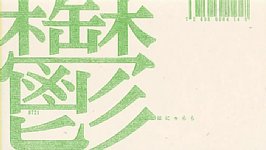
Yes, it’s “Depression†(鬱). (tl note: Haruhi fans should be familiar with this kanji!)
As one goes deeper and deeper into a world overflowing with eros, they turn to more and more extreme paths in that world. Despite the incredible sense of lust, Sensei’s heart is being eaten away by depression.
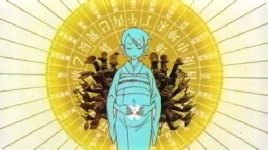
Kafuka’s pregnancy scene.
This is a mysterious scene, profound yet unexplained.
Next we have the second season, [Zoku].

This OP is a grotesque one, with persistent images of organs. The OP song is “Kuusou Rumba.â€
Unlike the first OP, this one started out in monochrome. This OP had the special trait of changing throughout the different episodes, cutting off midway in some versions and finally appearing in full color, surprising quite a few people.
The Manic Heart and Ero-Guro Nonsense seen in the [Zoku] Sayonara Zetsubou Sensei OP
The Mystery Hidden in [Zoku] Sayonara Zetsubou Sensei’s OP
The theme of this OP is “Mania†(èº), acting as a pair to the first season’s theme. It’s all extremely high-tension, wouldn’t you say?

Despite the OP’s colors being in plain monochrome, its actual content is so excited that you feel like you’re about to go mad.
Once color is added to all of this, a new, vibrant world is born.
Though, there is one girl who stays the same here. This girl:


That girl is the girl who we saw in season 1 pregnant with Zetsubou-sensei’s children, Fuura Kafuka (Pen Name).
Next, the [Goku] OVA series.
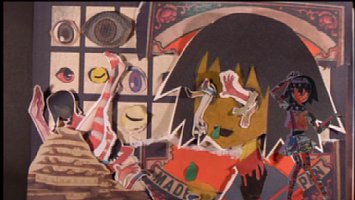
Now things are at the point where you can’t even figure out what’s going on. While it was called “A Professional MADâ€, we can see a complete lack of living characters here, the girls instead fully turned to objects.
[Goku] Sayonara Zetsubou Sensei and Jan Svankmajer: The Eroticism of Objects
Via “Depressionâ€ã€€(鬱), we fall into the confusion of “Maniaâ€(èº), and also into “Chaos†(混沌).
Feeling a sense of raw “Eros†and gazing at “Grotesque†death, we come to an underlying “Objectification†(物体化).
While wriggling between the boundary of “Truth†(真実) and “Pretense†(虚åƒ), their form changes shape and color.
While each of these views are incredibly symbolic and interesting possibilities, we discover from whose perspective these openings are all from in the final part of [Goku].
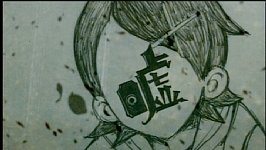
You’ve probably guessed by now. It’s Fuura Kafuka.
The reason this world is constantly changing is because of this girl’s inner fragility and instability.
Ambivalence Seen by the Girls’ Eye(s).
(tl note: Japanese has the luxury of being able to be vague on pluralization, relying on context to clue the reader in. In this case, I’m fairly certain that it is pointing to the girls’ eye (singular), but that sounds kind of awkward in English. Almost as awkward as a long translation note.)
The music this time is an arrangement by “Rapbitoâ€. While that may be surprising, there doesn’t remain a trace of the previous OPs’ sense of parody. Instead, they’ve created an entirely new work.
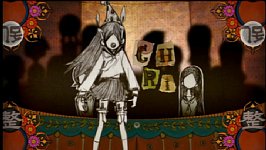

It’s almost as if it’s a MAD created by Gekidan Inukaree (note: Gekidan Inukaree, literally “Dog Curry Troupe,” is the individual/group responsible for the OP).
This OP is quite obsessed with certain details, one of which being that if you look closely in the corners of the frame, you can see characters representing the two sides of each girl.
Chiri is “Chaos†(乱)and “Order†(整).
Abiru is “Kickâ€ã€€(è¹´) and “Punch†(æ®´).
There’s also “Good†(å–„) and “Evil†(悪), “Victimâ€ ï¼ˆåŠ ) and “Aggressor†(被), “Seme†(攻) and “Uke†(å—), “Poverty†(貧) and “Wealth†(富), and so on.
Each character is represented by a pair of characters in this manner. (Well, kick and punch aren’t really opposites, but…)
Each girl’s “Existence-as-Presented†(イメージã®å˜åœ¨) is made up of two contradictory ideas. This dangerous tightrope act is at once fascinating and terrifying.
So, what about Fuura Kafuka, the girl in question?

“Mania†(èº) and “Depression†(鬱).
In other words, the OPs until now (Season 1: Depression, Season 2: Mania) have been expressions of the core of her inner world.
As you probably noticed by comparing this picture to the previous two, this image of the audience being nothing but Kafukas is once again symbolic, while also eerie.
Fuura Kafuka isn’t her real name. It’s a pen name. While we don’t officially know her name as of now, we see glimpse of it as “something like *this*â€. However, it’s never confirmed.
We even see a glimpse of this in today’s episode.
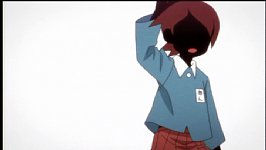
It’d be hard to say that this isn’t a young Kafuka. Her nametag reads “An.†(tl note: other possible romanizations are Ann and Anne. However, my overactive gaijin mind associates “アン” with a homonym “æš—”, “darkness”, so I’ve kept it as is.)
Of course, this doesn’t really go beyond another guess. While our main character, the Sensei, has relatively few mysteries surrounding him, Fuura Kafuka is nothing but mysteries.
Let’s take a look into such a girl’s state of mind.
The sorrowful psychedelic as seen by the girl’s eye(s).
Halfway through the song, the scenes introducing the girls one-by-one end, and the OP shifts to Kafuka and Sensei’s duet performance.
Well, since we might be seeing a story created by Kafuka’s psyche, we might technically call it a solo performance.
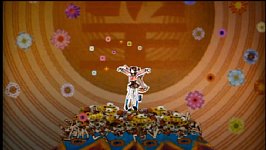
For example, the image of Kafuka dancing madly on a flower bed.
If we take a close look at this scene, we see a fairly awesome scene. (tl note: “awesome” in the biblical sense, not in the contemporary slang sense)
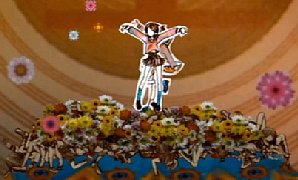
She’s actually dancing on top of the rubble of her classmates’ bodies.
Though, these aren’t really “corpsesâ€. The reason I say this is because the girls in the [Goku] series up to this point have already been objectified and dismantled.
If we were to see blood or organs spilled, this could be said to represent death, but since this MAD uses the technique of “Destroying the imageâ€, the “Girls’ Image†is replaced with lifeless objects.
Hence the girls’ world is an extremely inorganic one, one where the senses are fuzzy.
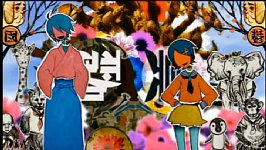
The scene with Sensei and Kafuka looks like this.
While Sensei has been turned to an image, barely resembling any sort of living being, Kafuka herself is also turned to a strange creature.
Nonetheless, if we look closely, the flowers here are, interestingly, “raw†ones.
In the background we see “Falsehood†(嘘) and “Truth†(真).
Once again, there’s a sense of ambivalence.
When one holds ambivalence like this, one is forced to choose to either struggle against it, or become an empty shell of a human being.
It seems as though Kafuka’s displayed positive attitude may be a result of her attempts to escape her own extreme thoughts of despair and uncertainty, replacing them with the ideas “all is inorganic†and “all is meaninglessâ€.
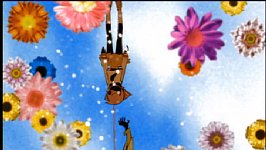
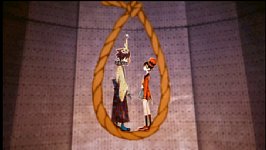
Of course, this interpretation is reliant on these OPs which are in some sense “professionally made derivative worksâ€, so its relevance to the work as a whole might be questionable, but the world we’ve seen up until now is full of contradictions. In order to stay alive in this world, one can’t choose A or B, but must simply float in between the two.
That the normally-hanged Sensei’s neck is nooseless this time, and that Kafuka is the one hanging seems especially symbolic. Also, the fact that the previously inorganic images in the OP are replaced with more and more live flowers also interests me.
Perhaps the inorganic paper-mache world is trying to break through the wave of “Depression†and “Mania†in order to then revive itself?
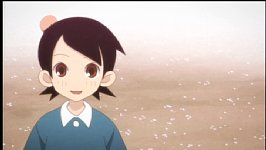
I just can’t figure out what color Kafuka’s world, the world illustrated by these OPs, is.
————————————
Revisiting the Zoku OP with “Fuura Kafuka’s Point of View†in mind, he gradual fading followed by sudden jump into color in the final episodes seems to also make sense.
On the other hand, we could also see this as “Fuura Kafuka as seen by Sensei.†In that case, we’d have to understand the OP in a totally different way, but there is that shot in the part 3 OP where we see Kafuka with her eyes downcast, possibly crying.
I think the key to figuring this all out is Kafuka’s attempt to objectify the world while Sensei tries to protect the flowers, which symbolize life.
Is it symbiosis, or is it codependence…
Finally, though this is about the main feature, the final episode of a three-part series having so much development shocked me. Check the manga story for more detail…


















